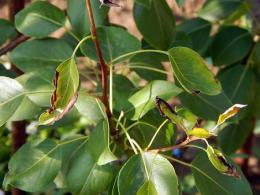Search
Login
Recommended
Pear turns black, why pear leaves turn black, useful tips
Quite often, from beginning gardeners, you can hear a complaint that the leaves on the pear turn black. There may be several reasons for this phenomenon, in order to choose a treatment option for this ailment, you should carefully study how the process of changing the color of the leaves occurs - this will help determine which negative factors (diseases, pests, weather conditions or lack of trace elements in the soil) caused the observed phenomenon.
Content:
- Why leaves turn black - the lack of trace elements can cause this phenomenon
- Bacterial infection - what is this disease and how to deal with it video
- Pear scab - taking measures to save the tree video
- Medianitsa
- Dry air leaves turn black on pear - how to treat a tree
- Aphids can cause blackening of leaves on a pear video
Why leaves turn black - the lack of trace elements can cause this phenomenon

It will be difficult for an inexperienced gardener to determine the cause of the blackening of the leaves. Therefore, to learn useful tips from experienced gardeners will not be amiss. A change in the color of the edges of the leaves, and later on the tops of young shoots, may indicate a lack of calcium, as a sufficient measure in this case will be the introduction of calcium nitrate into the soil.

If pears are grown in the southern regions, then a similar picture can be observed when the tree is damaged by bacteriosis, as a treatment, you will need to spray the affected plant with fungicides such as Strobi, Skor and similar preparations.
If, with the blackening of the leaves, the formation of rosettes from the leaves at the tips of the branches and the drying of the top of the tree, growth inhibition is observed, then the pear most likely experiences starvation.
With a lack of iron, blackening of the foliage is not observed, on the contrary, it becomes unnaturally light, acquires a straw-yellow hue. Insufficient amounts of copper cause wilting of foliage and young shoots.
An effective means of combating such ailments will be spraying the tree with solutions containing trace elements and fertilizers: iron or copper sulfate, boric acid, etc.
Bacterial infection - what is this disease and how to deal with it
Sometimes this disease is also called a bacterial burn, it affects fruit trees most often, in particular - a pear. The first symptoms of the disease usually appear in June, they are expressed in blackening of the leaves, it begins from the central part. Young shoots can change color to brown, and then black shoots can also turn black, their appearance becomes like a fire went through them.

The cause of the disease is an infection that has got through cracks in the cortex or stomata of the leaves. Penetration of it can also occur when pruning branches with a non-sterile tool. Moving along the trunk along with the juice, bacteria infect the entire plant. The active development of bacteria in the tissues of the tree causes their rapid death.
Saving a pear in this case will be a difficult process, but you can still try. Effective drugs will be antibiotics such as penicillin, thiomycin, agrimycin. They are bred in water and sprayed throughout the plant. The first spraying is carried out when the pear blooms, the subsequent ones are performed with five-day intervals.
Some experienced gardeners claim that you can also get rid of a bacterial burn by spraying all the plants in the garden with a solution of copper sulfate in milk of lime. Before proceeding with the processing of plants, you should make sure that the resulting solution has a neutral reaction - an excessive amount of copper sulphate can damage the leaves of plants, with an excessive amount of lime, the efficiency of processing the solution will decrease.

To prevent pear contamination during garden processing, all tools that are used for gardening should be disinfected. It is not sad, but if treatment with the recommended drugs did not give the desired effect, the tree will have to be removed from the site and burned.
Pear scab - taking measures to save the tree
Considering the question of why pear leaves turn black, one cannot help but recall such a common disease as scab. The origin of this disease is fungal, it occurs quite often and, in addition to leaves, affects shoots, flowers and fruits. Blackening of the leaves over time causes them to die and they fall off. Thickened tree planting threatens the rapid spread of scab from one tree to another. Fighting with scab should be serious - it has a negative effect on the state of the tree itself, leading to a decrease in its yield.

Wet weather, which persists for a long period, activates the growth of scab spots. Appeared black spots on the sheets grow rapidly. Among the factors that influence the activity of the spread of the disease, experts call:
- weather,
- resistance of the variety to fungal infections,
- the age of the tree.
With the disease running, part of the crop is lost altogether, the surviving fruits have low taste, are stiff and have spots on the peel.
The scab pathogen overwinters on young shoots of trees, causing the appearance of swollen patches and wound surfaces at the locations of the pathogenic fungus. The defeat of the fruit is accompanied by the appearance of black-olive spots on their surface, which can merge into a single whole. Long-term exposure to infection leads to the fact that it acquires a cork-like texture, stops growth, and cracks.

The fungus Dothideales causes the scab of the pear, it can live exclusively on pear. Among the varieties resistant to defeat by this fungus are: Lyubimitsa Klappa, Exhibition, Gurzufskaya, Victoria, Dessert, Strawberry, Smuglyanka.
More prone to scab disease: Favorite Yakovleva, Marianna, Phelps, Forest Beauty. Naturally, the protection of such varieties will need to be given special attention.
Scabs will help prevent an epidemic:
- correct site selection
- competent pruning of trees in the autumn-spring period,
- removal of shoots, leaves and fruits on which signs of scab lesion were observed.
The preventive treatment of trees is of great importance, they must be done repeatedly, in accordance with the recommendations on the use of certain chemicals. For example, in an area with an excessively humid climate during budding, the crown will need to be treated with a 3% solution of Bordeaux mixture, then, in the phase of bud appearance, with Topaz or Horus preparations. These same drugs should be used after flowering.
Antibiotics are used to treat pears for scab, and solutions are prepared according to the instructions. Pear treatment should be accompanied by preventive measures:
- harvesting and disposal of fallen leaves and fruits, on which scabs capable of infecting new trees are preserved,
- since the fungus can exist even on the ground in the root zone of the tree, the area around the trunk should also be treated with chemical preparations.
Medianitsa

This small brown-black winged insect can safely jump and fly from branch to branch or from one tree to another. In order to soak the larvae and adult tinnitus suck juices from leaves and shoots. The depletion of a tree in the event of an attack by a large number of insects leads to the death of flowers, falling of the ovary, and a decrease in the size of the leaves. Larvae of the tinnitus in the course of their life emit sticky dew, which glues the inside of unblown buds and peduncles, young leaves on the shoots. Sticky honey secretions contribute to the development of sooty black fungi on them.

If the leaves on a pear turn black due to the defeat by a tinker, do not hesitate to do it for a long time:
before the buds open, it will blow away to treat the tree with hot water, its temperature should be within +60 C,
in the period between the opening of the buds and flowering, processing of the crown with a solution of malathion will be required. Folk recipes for getting rid of tinnitsa are recommended to be sprayed with tinctures of tansy, garlic, and onion husk infusions with the addition of wood ash during the growing season.
With a significant increase in pear of adult insects, the tree should be treated with a solution of trichloromethaphos.
Dry air leaves turn black on pear - how to treat a tree
With insufficient air humidity over a long period, darkening of pear leaves can be observed even in those trees that receive moisture through systematic irrigation. The presence of a large number of dust particles in the dry air has a negative effect on the leaves. Most affected are pear varieties recommended for cultivation in the southern regions. An effective measure to combat this kind of problem may be to use watering according to the principle of spraying on a leaf
Aphids can cause blackening of leaves on a pear

Of course, such a picture will be observed upon the invasion of a large number of aphids.

Their constant need for nutrition will lead to the fact that the tree will lose a significant part of its nutrients, as a result, the leaves on a tree that has grown exhausted will darken and twist, and inside of them, aphids that parasitize on the tree can be found.
The most effective method of combating these harmful insects will be spraying pears with special chemicals from aphids at the recommended times.





